The once industrial Lille is worth a visit on your way to London, Paris or Brussels with a beautifully restored old town that will surprise you. Its flamboyant architecture, a perfect harmony of brick and stone on richly decorated façades, is reminiscent of a prosperous past. Today, Lille, on the border with Belgium, is a thriving city with more than one million inhabitants and a plethora of restaurants, brasseries and cafés.

The Grand’Place

At the heart of town, the Grand’Place is the place where the Lillois (the residents of Lille) and the tourists converge. The square is also named Place du Général de Gaulle after the famous French statesman who was born in Lille in 1890. Almost entirely car-free, the Grand’Place is surrounded by houses typical of Flanders architecture from the 17th to the 20th centuries.
In its centre stands the “Colonne de la Déesse”, a monumental pillar topped with a statue of a Goddess which commemorates the siege of Lille by the Austrian army in 1792 at the time of the Revolution. Initially, the statue was to be placed on top of the Arc de Triomphe in Paris but it stayed in Lille.
Back in the 11th century, the square was used as a wheat market place. Today, shops, cafés and terraces make this square an ideal starting point to discover the old town of Lille.
The Old Stock Exchange (Vieille Bourse)
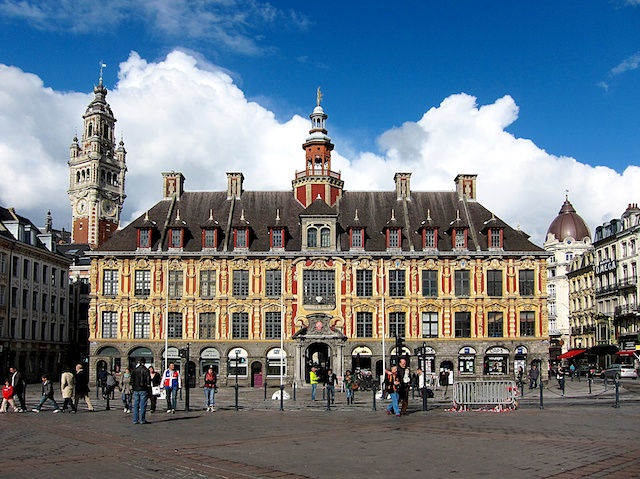
The Old Stock Exchange (Vieille Bourse) was built between 1652 and 1653 by Julien Destrée in order to provide the merchants with a fine building similar to the Stock Exchange of Antwerp. Located between the Grand Place and the Place du Théâtre, this prestigious building evokes the intense economic activity of Lille during the 16th and 17th centuries when the city was a major competitor with the neighbouring cities of Bruges, Ghent and Antwerp. Once known simply as the Stock Exchange, this historic monument, listed in 1921, took its current name when the new Chamber of Commerce was built in 1910. The Vieille Bourse is rectangular in shape and is actually comprised of 24 identical little houses stacked together around a central arched courtyard. The courtyard now houses a flea market with stalls selling second-hand books in the afternoons.
Its architecture derives from the Flemish Renaissance of the 17th century, combining colourful decorative shapes such as fruit garlands, horns of plenty, pilasters and trumeaus. Between the windows of the first floor, the pilasters form the shape of sculpted bodies which is a pagan symbol for the commercial life of Lille. At the top of the campanile, a statue of Mercury is a reminder that the god used to be the emblem of the Lille Stock Exchange.
The Grand Garde
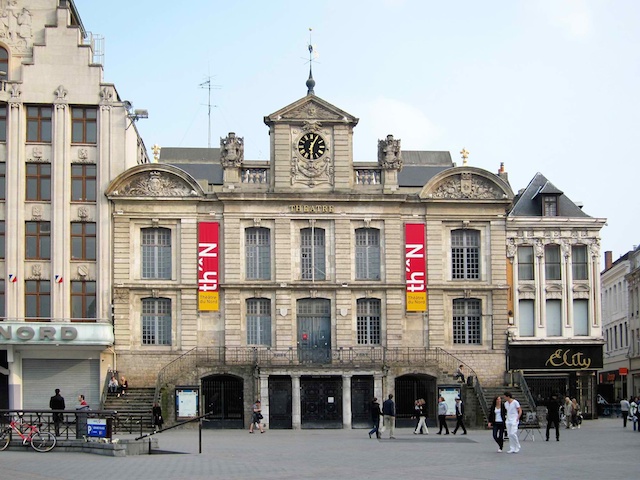
This French-style mansion was built in 1717 by Thomas Joseph Gombert to house soldiers from the sentry guard whose primary mission was to ensure order in the town. The Grand Garde symbolises the presence of the King of France who annexed Lille in 1668. The Grand Garde now houses the “Théâtre du Nord”, directed by Stuart Seide.
The Voix du Nord building
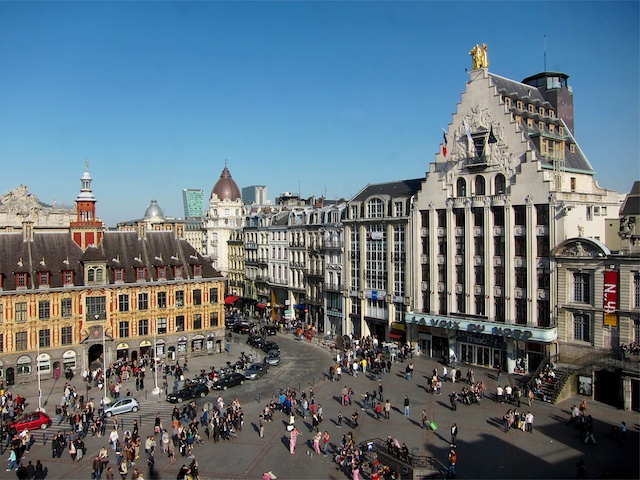
Next to the theatre is the home of the local newspaper, La Voix du Nord (the voice of the North). Built in Art Deco style, the façade contains 28 windows which symbolise the 28 printed issues of the newspaper. The building is crowned by a Flemish step gable supporting a gilded statue of Artois, Flanders and Hainault sculpted by Victor Laprade in 1932. A large shopping centre can be found inside on the ground floor.
Place du Théâtre
Behind the Old Stock Exchange is the grand Place du Théâtre, which is surrounded by some monumental buildings.
New Chamber of Commerce (Nouvelle Bourse)
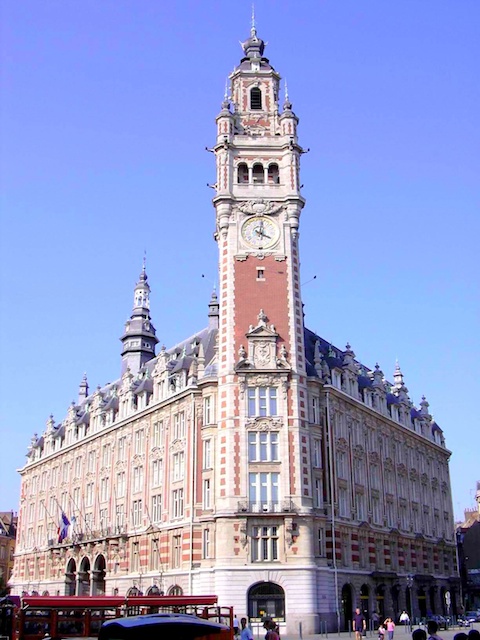
The New Chamber of Commerce (or Nouvelle Bourse) was built between 1910 and 1921 by Louis-Marie Cordonnier in neo-Flemish Renaissance style to replace the Old Stock Exchange which had become too cramped. The rich decoration of the façade with motifs depicting plants and spiral scrolls is reminiscent of the majestic town-halls of the Low Countries.
A 76 metres high soaring spire completes the structure and dominates the two squares of Grand’Place and Place du Théâtre. Its clock contains four sundials and its belfry contains 25 bells. The indoor courtyard with its frescoes and galleries surrounded by pilasters is enclosed with a beautiful cupola. It is the headquarters of the Chamber of Commerce and Industry of Greater Lille.
Lille Opera House
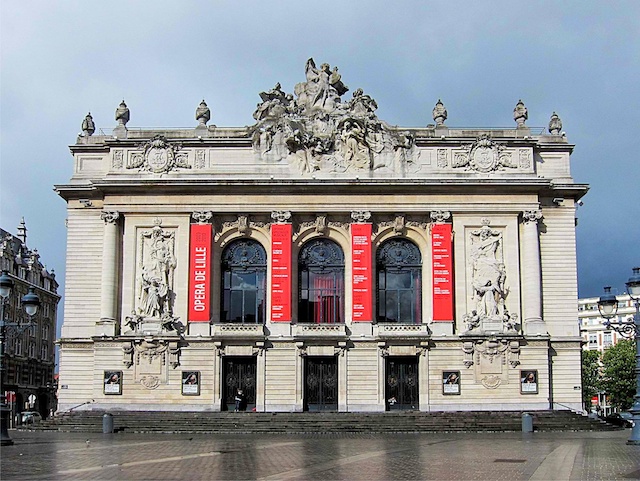
Next to the Chamber of Commerce, the grand neo-classical building of the Lille Opera was built between 1907 and 1913 and was inaugurated in 1923. Miraculously untouched by the First World War bombings, it replaced a former building which was destroyed by fire in 1903. The architect Louis-Marie Cordonnier was commissioned to rebuild an Opera House in the style of those of Paris and Monte Carlo by Charles Garnier.
Saint Maurice Church
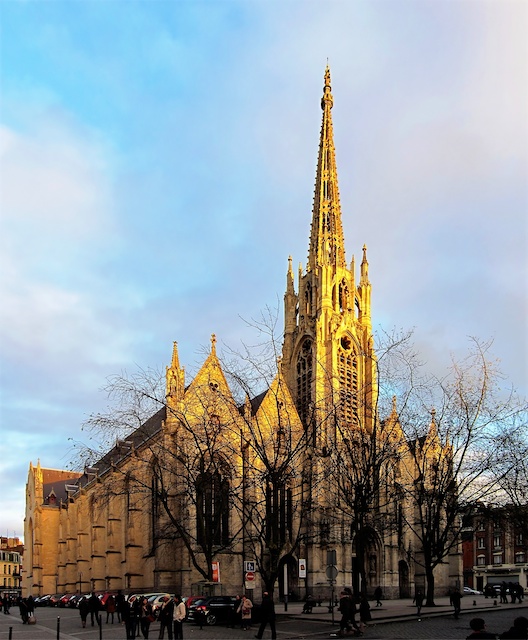
The Saint Maurice Church located on Rue de Paris, not far from the Grand’Place, is one of Lille’s finest churches. Its construction took four hundred years from the 14th to the 19th century. Listed as a historic monument in 1840, it unusually combines a Gothic church hall with a nave surrounded by two doubled-sided aisles of approximately equal height. A style quite rare in church architecture, Saint Maurice combines a church hall with a walkway that includes three recessed chapels.
The Vieux-Lille

The old part of the town of Lille (Vieux-Lille in French) reveals what this northern district used to look like in the 18th century with its rows of houses which were identical yet all decorated differently. This area has great character and charm and includes several buildings dating to before the 19th century. It has retained many cobbled streets and some canals which used to crisscross the town in past centuries.
The part of town around Rue de Béthune, Rue du Molinel and the railway station
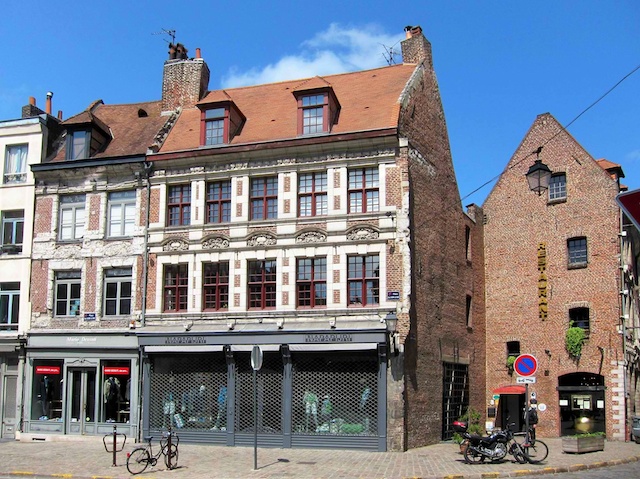
Rue Faidherbe and Rue de Béthune is where a regional setting was created during the city’s reconstruction after World War I.
After the restructure of the popular district of Saint-Sauveur in the 1930s and 1950s into the new town-hall, the Vieux-Lille remained the last part of town dating back to before the Industrial Revolution.
Completely restored under the mandate of Mayor Pierre Mauroy, the Vieux-Lille has today evolved into a thriving commercial and tourist zone.
The old town of Lille contains several other historic buildings: the Sugar Exchange Hall (Halle aux Sucres), the Conservatory, the 18th century Hôtel de Wambrechies (which housed the bishopric) and the Hôtel Crépy-Saint-Léger (Banque de France).
The City-Hall and Belfry of Lille

The City-Hall of Lille was built between 1924 and 1932 by Emile Dubuisson on the square Roger-Salengro, located in the Saint-Sauveur district. The City-Hall of Lille was listed as a historic monument in 2002 and its belfry is now incorporated in the UNESCO world heritage list of the belfries of France and Belgium.
The architect was inspired by the triangular-gabled Flemish houses and combined different elements in its construction: concrete, bricks, stone from Béthisy and ceramics. At the left angle, the 104-metre high belfry is the highest and the most recent of the Flanders belfries, entirely constructed of concrete. The tower makes Lille town hall the tallest municipal building in France. The view from the top embraces the whole city of Lille, the hills of Flanders and the distant slag heaps of the mines.
The Lille Palace of Fine Arts (Palais des Beaux-Arts)

The Lille Palace of Fine Arts is one of the largest museums in France and the biggest museum of fine arts in terms of artworks exhibited, apart from Paris. It offers more than 200 sculptures, paintings and objects from the European middle ages and the Renaissance, more than 500 paintings from the 16th to the 20th centuries, 135 sculptures from the 19th century and many other artworks. It was built in 1792 and inaugurated in 1892. From the outside, this big building looks impressive. It is located in the centre of a large square with many beautiful fountains. The palace itself was listed in the inventory of historical monuments in 1975.
The three gates of Lille and the Citadel
Porte de Roubaix
The Roubaix Gate was cut into the former ramparts built by the Spaniards in 1621. It includes two lateral arches.
![Porte de Roubaix (Outer side) © Velvet - licence [CC BY-SA 4.0] from Wikimedia Commons](https://frenchmoments.eu/wp-content/uploads/2012/11/Porte-de-Roubaix-Outer-side-©-Velvet-licence-CC-BY-SA-4.0-from-Wikimedia-Commons.jpg)
Porte de Gand
![Porte de Roubaix (from the inner side) © Velvet - licence [CC BY-SA 3.0] from Wikimedia Commons](https://frenchmoments.eu/wp-content/uploads/2012/11/Lille-Porte-de-Gand-by-Velvet1.jpg)
Located next to Rue de Gand, this attractive three-level gate today houses a restaurant on the top floor.
Porte de Paris
![Porte de Paris in Lille © Vigneron - licence [CC BY-SA 3.0] from Wikimedia Commons](https://frenchmoments.eu/wp-content/uploads/2012/11/Porte_de_Paris_Lille-by-Vigneron1.jpg)
Located on the square in front of the town hall, the Paris Gate (Porte de Paris) is the most impressive in Lille. It was built between 1685 and 1692 as a triumphal arch in honour of Louis XIV who had recently annexed Lille. The gate contains the coat of arms of Lille (one fleur-de-lis) and of France (three fleurs-de-lis). On top of the arch, two angels surround an allegoric statue of “Victory” depicted in the midst of flags, her arms lifted, ready to lay a crown of the head of the Sun King. The portal bears a statue of Hercules on the left (a symbol of the royal strength of the king) and of Mars on the right (a symbol of the war won by Louis XIV). The original ramparts were dismantled in 1858 to reveal the circular gate surrounded by a moat garden.
The Citadel of Lille
![The Citadel of Lille © Remi Jouan - licence [CC BY-SA 3.0] from Wikimedia Commons](https://frenchmoments.eu/wp-content/uploads/2012/11/Citadelle_Vauban_Lille_Boufflers-by-Remi-Jouan1.jpg)
This pentagon-shaped citadel was commissioned by Louis XIV following the annexation of Lille and was constructed between 1667 and 1670 by Vauban. Vauban designed a fortification line made up of the towns of Gravelines, Dunkirk and Maubeuge-Rocroi. These citadels played a defensive role in controlling the borders between the Kingdom of France and Belgium. Lille citadel comprises a little self-contained town surrounded by five bastions and five demi-lunes (half-moons) in a star-shape pattern. It can house an army of 1,200 soldiers and is still used by the French army. Porte Royale, with its drawbridge, acts as the main entrance to the citadel. The gate symbolises the royal presence of the King of France. Lille citadel is a closed military zone and visits take place only by prior appointment with the Lille Tourist Office with at least 24 hours notice (bring a passport or national ID card).
Lille Tourist Office: http://www.lilletourism.com
Featured image: Grand Place effet maquette © Laurent Ghesquière


